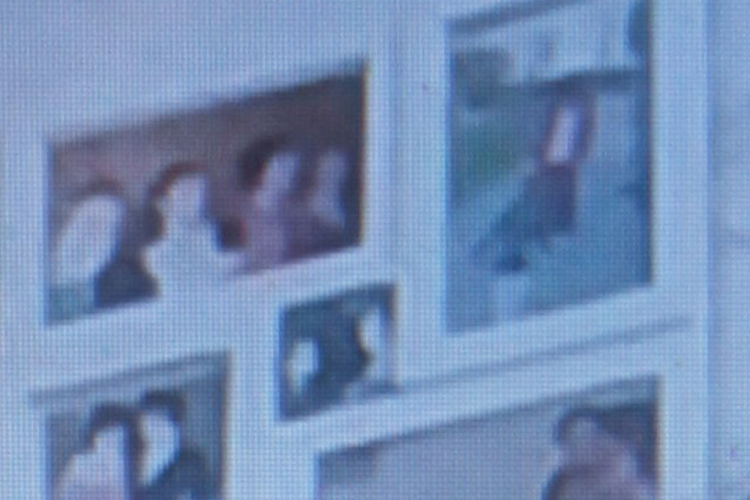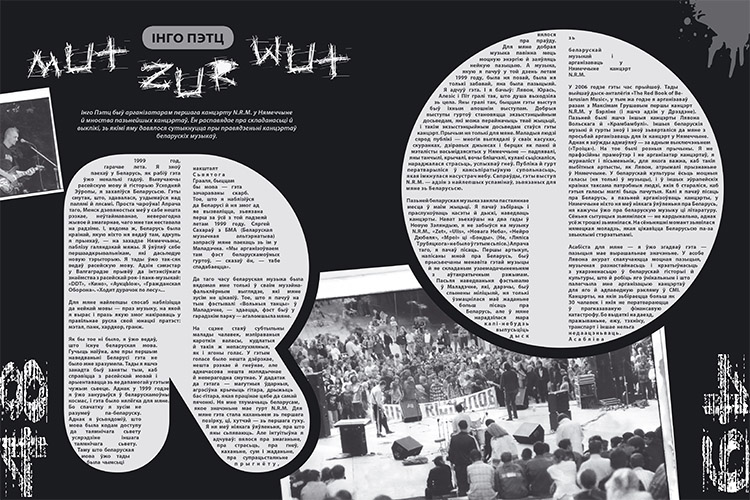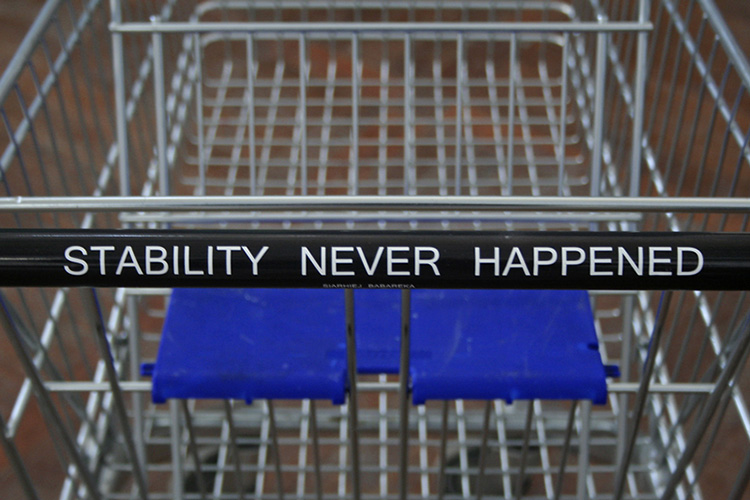
Аўтар: Tania Arcimović, 05/12/2014 | ART Cult Aktivist interview
MAXIM TYMINKO: TRANSFORMATION INTO A VISUAL STEAM
Belarusian artist Maxim Tyminko left the country in the mid-1990s. In 2005 he graduated from the Academy of Media Arts in Cologne (Germany), and has been living abroad since then. Now you can find him in Cologne and Amsterdam: living between several cities is an ordinary practice for contemporary Western artists. However, whenever Maxim is invited to come to Belarus, he accepts the proposal even despite of the lack of the due conditions. Thus, the «comic strip» «Five Lyrical Songs about Physics» (originally presented as a video) was exhibited as a part of the project «Zero Radius. Art Anthology of the 00s». The video «935 Elements» was shown at the exhibition «OFFSIDE» becoming one of the exhibition’s central works, since for Belarus such a media is relatively new.
In the mid-1990s Maxim Tyminko also was a participant of a number of exhibitions in the gallery «The 6th Line» and currently his work can be seen in Minsk again at the forum «Suma Sumarum» organized at the Center of Contemporary Arts. He arrived from Germany to install his work himself, moreover he held a series of presentations and even performed an opera-report «Projector».
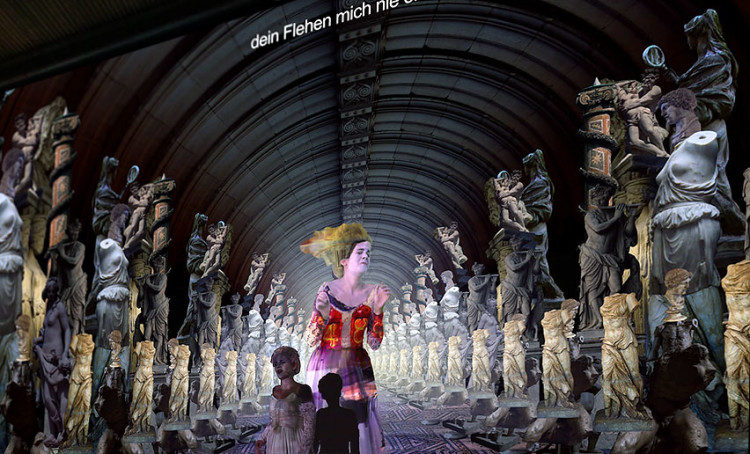
Maxim Tyminko, from the live opera performance Beguiling Orpheus / photo by M.Tyminko
Maxim, before our meeting I have run through your CV one more time, and I immediately had a question: have you ever studied at our Academy of Arts? Somehow I thought that you were Andrej Durejka’s fellow student.
Maksim Tymińko: I have not studied at the Academy of Arts, but I did study with Andrej at Art College in Minsk. After Hlebaŭ’s College I tried to enter the Belarussian State Art Academy once, but I did not succeed. Rather, my name was already on the list of those who had passed the first round, I only had the Belarusian language left to pass. But the next day I was crossed off the list. Probably they recalled about my past at the college. Our group (which is Andrei Dureika, Kirył Chłopaŭ, Alaksandr Kamaroŭ and others) were a sort of «enfant terrible» because we were too active: we held performances and alternative exhibitions both around the city and at college. By the way, our diploma was a collective performance, too. At that time we claimed not to have any individual authors, to be all equal. And there was a choice whether to give all of us either unsatisfactory or excellent marks, there was no other option.
And I was also a hooligan myself: a sort of a young punk, together with Siarhiej Pukst, Dzmitry Łoś and Kamaroŭ we organized a group called «The Bee King» and staged punk concerts. I am sure that all of us were known at the Academy as «unreliable elements». It was 1991. Then I was glad that I did not enter the Academy, although I had to join the army. But in the army I performed the functions of an artist in the «club», and during my military service I even managed to participate in the famous exhibition «The Lessons of Bad Art» in the Palace of Arts in 1992.
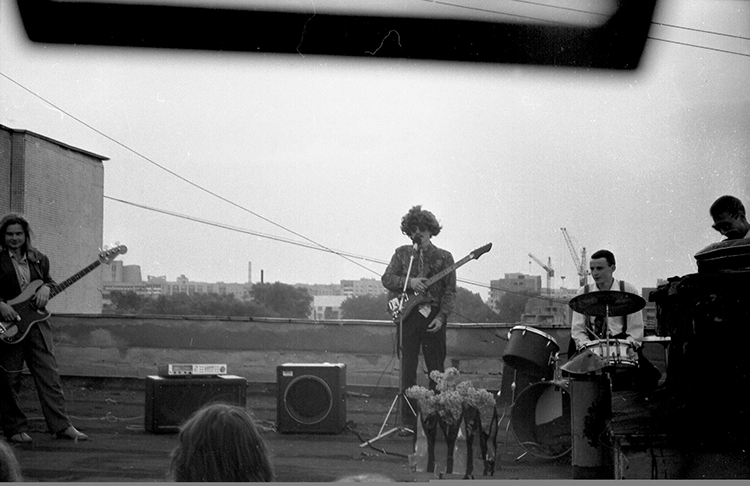
«The Bee King» / 1993 the concert on the Niamiha house-top
What kind of project was it? Many people call it a landmark one.
М.Т.: In a sense, for many it was an exhibition-manifesto. In the first place it had an anti-academic nature. After the show, for example, Andrej Durejka got expelled from the Academy of Arts. It seems to me that Ihar Cišyn who organized it left Art College. But I do not remember this story well, because at that time I was in the army.
The next big project was the exhibition «Liebschaft» also set at the Palace of Arts. It was a group project, presenting a good example of the artists’ self-organization. Formally, it had a curator, but we did everything it ourselves. It turned out to be a big event — with film screenings and concerts. Then a group was formed including Andrei Dureika, Vitald Laŭčenia, Anton Slučanka, Alaksiej Cierachaŭ, Jahor Hałuza, Uładzimir Fiodaraŭ and myself. Together we made several more exhibitions. I find one of the most important ones to be the show «The House of Peoples’ Friendship» set at the House of Peoples’ Friendship accordingly, where I first consciously completely abandoned painting and demonstrated my first purely media-based work, a film-installation to be exact. It consisted of three 16-mm film projectors and three screens.
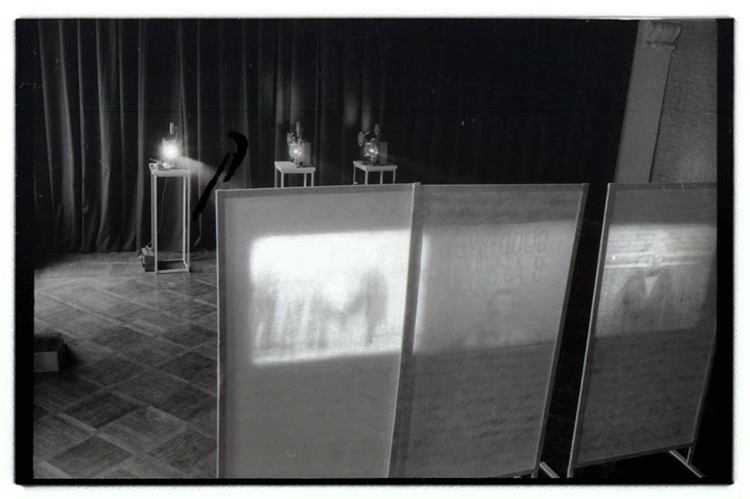
Maxim Tyminko, exhibition «The House of Peoples’ Friendship» / photo by M.Tyminko
That seems to be of a particular interest, because what you have been doing by now still remains new for the Belarusian art context — I mean in terms of the form. And then, in the 1990s, where did you get that knowledge? Where did that need in something different come from? The need in that very media.
М.Т.: To tell the truth, I started shooting on 8mm film and later on 16mm one when studying at college. We used my photos as a background projection for the concerts of «The Bee King» as well as for group performances. So, in around 1990 we staged a big, really multimedia play «We are Going to Liverpool» based on Daniil Kharms’ «Elizabeth Bam». Then I was experimenting with animation and stop-motion pictures. But first my approach was more intuitive. That is I have always had a thirst for something unstable, temporary. I even used tracing-paper as a surface for my paintings, which were torn in some places already in the working process. But this ephemerality has always appealed to me, besides I was interested in motion.
That is why I was getting more and more involved into moving pictures, cinema and gradually shifted my interests into the sphere of video and media arts.
After the exhibition at the House of Peoples’ Friendship there was one more show at «The 6th Line». I also set a media installation there and my first «media performances».
I would like to ask you about «The 6th Line» at once: what role did it have in Minsk at that period? Was it noticeable in the city map?
М.Т.: First of all, it was an important event for Minsk, in my opinion. It was the first place where on a regular basis contemporary art was exhibited. And for those times the appearance of the gallery was very natural, since everyone was longing for something new, any platform was making its sites available for free. We could hold exhibitions and concerts in the House of Peoples’ Friendship, at the Palace of Arts, even inside the building of the University of Informatics and Radioelectronics — all the doors were open to us.
Thus in the context of these freedoms the appearance of «The 6th Line» was logical and tuned up with the spirit of the epoch.
Was «The 6th Line» a certain artists’ community?
М.Т.: I would not say so. Actually, we did not communicate with one another. There were some small groups, such as ours. But then around «The 6th Line» there were lots of different other artists. It was rather a point of attraction for various circles.
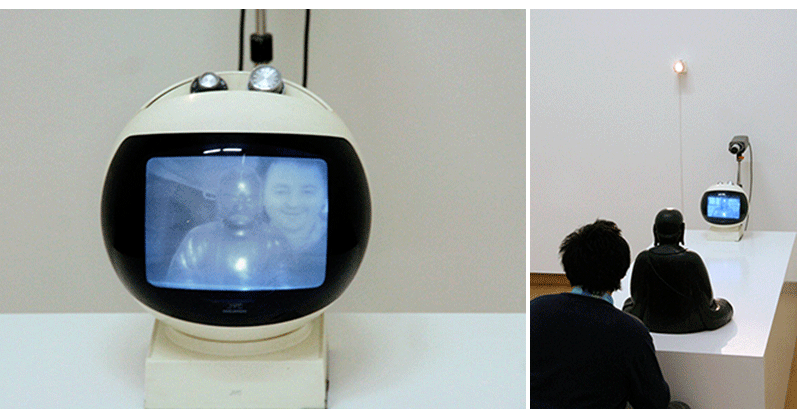
«I’m in Nam Jun Pike» / photo by A.Dureika
But you left before it was closed, didn’t you?
М.Т.: Yes, I did. But I did not pursue such a goal, because there was a time when everything seemed to be possible. But after the «referendum» and the return to the Soviet flag and coat of arms I suddenly felt oppressed and I felt: that was it, nothing would go on further, apart from working for some advertising agency. And to develop further one needs to leave the country… Then I learned that «The 6th Line» got closed and «a Šaranhovič’s museum» appeared instead. It became clear to me that the repressive methods were being reborn in a new form. That is «The 6th Line» disappeared as logical as it had appeared.
In a press release of the project «Suma Sumarum» Natallia Šaranhovič noted that the Museum of Contemporary Fine Arts, which she now heads, took up the baton of «The 6th Line»…
М.Т.: This is a complete concept substitution. Yes, they employed her to destroy this idea.
And what is your attitude to the discussion around «Suma Sumarum» — about «collaboration» of those who agreed to take part in the project staged on the territory of «the enemy»?
М.Т.: I think it is nonsense, and moreover it is counterproductive. This question, of course, can be raised, but in Minsk authors find themselves in a situation where there are absolutely no conditions for adequate exhibitions, they have neither means nor equipment for that! First I was touched by this discussion, but then I thought that I would not join it, there was some parochialism, some local style around it. Gallery «Ў» appeared, and people immediately started to judge it negatively complaining about its secrecy, reserved nature of the elite groups who had access to it and so on. Klinaŭ participated in the Biennale in Venice and he started being called a skunk and a traitor. Rusłan Vaškievič and Aksana Žhiroŭskaja made «Zero Radius» — again it was harshly criticized! They were claimed not to be selecting the participants correctly, for instance overlooking female artists. As if Žanna Hrak or Maryna Napruškina are not females. Now Iryna Bihdaj is working at this project, and again — it is linked with collaboration and given all sorts of obscene curses.
Obviously, we all make mistakes, one cannot but make them in such a situation. But why should one call others collaborators? Do many new radical and tough exhibitions appear after these arguments? Do many new young artists emerge?
Of course, I watch it from the outside, it is a sort of not my business — I just come to the city and go away. But in fact I feel sorry when observing the situation, since after all everything is very complicated … All rests here only thanks to the initiative of a very small number of people. But the initiative, as we see it, is punishable. Apart from the fact that it is not so simple to organize something, there are people from «our own camp» who mercilessly destroy every intention and «the activists» themselves unfairly criticize one another instead of providing support. Boycotting, blaming, cooking a hare before catching him lead to nowhere. After this trip a strange feeling remained, to be honest.
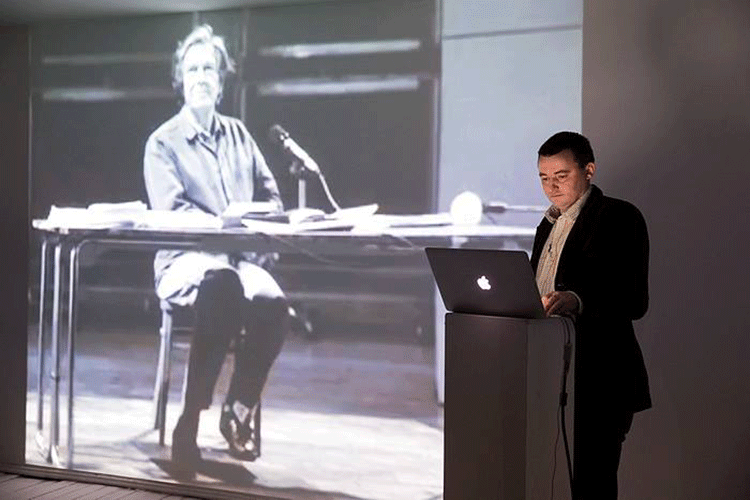
Maxim Tyminko / during the opera-report «Projector». Photo V.Ščarbakova © Goethe-Institut
Indeed, on the one hand, such discussions are dangerous — often its participants even cross ethical boundaries. But, on the other hand, this aspect — cooperation with state structures — also needs to be discussed. For the independent sector the question of collaboration is constantly open, and each time decisions are made based on the specific situation.
М.Т.: Once again, in this case I do not think it is productive. It rather leads to a general depression, destructive moods. There must be art criticism based on the questions: is this art contemporary or not? Does it correspond to the time? And to criticize exhibition sites and institutions … Yes, it is the enemy’s territory, but it is given for free. Whereas «friendly» territories expose you to a commercial prices. I have nothing to add. I know about the discussions around the exhibition «From a Square to an Object» in «BelExpo», I saw what was going on there.
And here we must not talk about the collaboration, but just about the terrible quality of art. In my opinion, the curators of the event vandalized pieces of art.
But you don’t mean that the works themselves were terrible, do you? In my opinion, this is a bright example of appropriation: separate works that in another context would correspond to the goals of contemporary art, in «BelExpo» were transformed into a set of meaningless gestures and symbols. But what did the artists expect themselves, when they agreed to participate? That is the question.
М.Т.: As far as I know, in many cases it was not the artists’ choice. If it had been, then it would be possible to give criticism. I have no worries about our exposition at the Center of Contemporary Arts. It is certainly not revolutionary, being also limited in scale due to the transportation needs, because we all transported the objects of art on our own. But I can tell you for sure that I did everything I could to defend my work’s quality and make the exposition as close to the way I see it in those conditions. Yes, I could have refused to do it, but I believe you need to capture all possible spaces, to do it as honest as you can and not following «their» rules.
Of course, the system creates a completely obsolete Soviet-like rules aimed at opposing the artistic process. And the people who work in this system may be nice guys in ordinary circumstances, but they seem to hate everything they do and hate «contemporary» art and artists who «are only able to spoil and crap.» But this is the system, and exhibitions at such institutions are not collaboration, but a way to loosen the system from inside. At least, this is how I imagine it.
We need to talk about the quality of art, about definite results, not about the curators’ or the artists’ unprincipled approach caused by «their stepping into the enemy’s territory».
It general, one should not have made any exhibition at «BelExpo». I would never agree to be surrounded by those panels with chrome pipes and clinches, marble floor and chandeliera a la the Opera and Ballet Theatre. Yes, the Center of Contemporary Arts looks like a barn, but we tried to match its environment. And I did not want to be exposed at the museum «At the Crossroads», not because they are enemies, but just because I could not imagine how in that room I could show my works and set a performance. In my opinion, that place is not designed to display art. One must raise such issues.
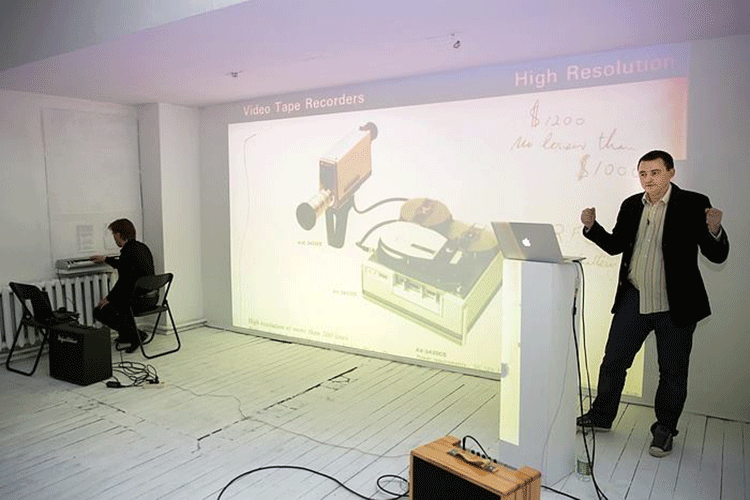
Siarhiej Pukst, Maxim Tyminko / during the opera-report «Projector». Photo V.Ščarbakova © Goethe-Institut
Let us go back to the exhibition «Suma Sumarum»: how did you react to Iryna’s proposal? Since so much time has passed, moreover there was no financial support at all.
М.Т: First I thought there would be nothing. But Iryna acted as an excellent manager and did the impossible. I give her my praise and show honor, and such actions as hers should be supported. First I agreed in theory, I knew that still it would not be possible to exhibit what I wanted: I forgot about video installations in Minsk long time ago. So, I did not believe, but then it became reality, arrived at the discussion of specific things — conditions and possibilities. And I was lucky, in that very period Goethe-Institute in Minsk invited me to deliver a lecture — it was that opera-report, and I had a reason to come. If not for that, I would have thought many times whether to come to Belarus or not.
On 13 December there would be a final discussion where the project’s outcomes would be analyzed. What do you think is the future of «The 6th Line»?
М.Т.: I fully support it, let them be revived, if there are such possibilities. The more of such projects are, the better.
And finally, I would like you to tell a little bit about what you are doing now. Unfortunately, these forms are still rare — both for the Belarusian authors and for the public. This, of course, is primarily due to the education and, of course, budget.
M.T.: I find it difficult to determine my genre or my materials, I always say that I do arts. Well, I use a variety of media and forms. I am actively working with video, installation, photo collages, computer programming. At the exhibition I presented my «comics strips» and a performance, I produced the opera-report. By the way, it was an experiment for me, where I decided to combine the lecture format with the elements of performance, song and dance.
I do not limit myself in the selection of materials, but most of all, one way or another, my works can be defined by such a concept as media art.
Unfortunately, it is a complicated issue for Belarus. But, actually, it can be found everywhere. And the difficulties are connected not only with the lack of education (although in Belarus the absence of any adequate art education is just a real cultural catastrophe), but they have much deeper roots — the inability of the contemporary art market to adjust to completely new conditions related to the emergence of new representational resources. This is what my opera-report «Projector» was about.
When I mention the financial component, I mean that in order to show your work — the opera «Beguiling Orpheus» — mere enthusiasm was not enough. The equipment expensive for Belarusian independent art institutions was needed.
M.T.: That’s true. Firstly, there must be a live singer. Secondly, the projection should be of a certain quality: certain brightness, height and space dimensions. And for some reason this seems to be impossible both for institutions or for sponsors.
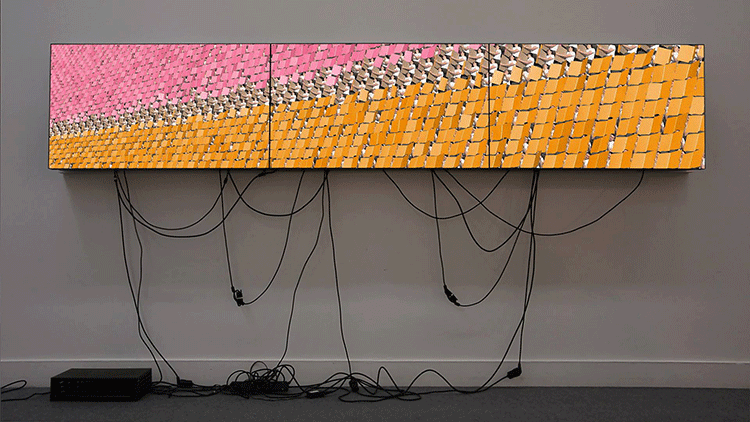
Maxim Tyminko «939 Picture Elements» / installation
What topics are you interested in at the moment?
M.T.: My latest piece of art is the opera-report «Projector», in which I deal with several topics that I have been interested in lately.
These are fundamental changes that are currently taking place in visual arts: the transformation of an art object into the event, and of an artifact into a visual steam.
And a very serious problem of preservation of visual works arises from this. I am also interested in new relationships within art space, the idea of the need of a new artistic profession — that of an artist-performer (by analogy with a musician-performer) — and providing it with the same status. And, of course, the importance of the development of my own visual «sheet music» record as a new and effective method of communication between the artist and the performer. This is what I am dealing with at the moment.
Interviewed by Tania Arcimovič. Translated into English by Volha Bubič
Opinions of authors do not always reflect the views of pARTisan. If you note any errors, please contact us right away.



